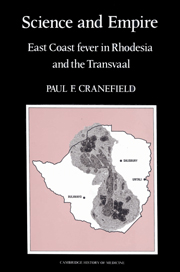Book contents
- Frontmatter
- Contents
- List of illustrations
- Preface
- Acknowledgments
- 1 Prologue
- 2 The places and the players
- 3 A new disease?
- 4 The search for an expert
- 5 Robert Koch in Bulawayo
- 6 Joseph Chamberlain
- 7 Arnold Theiler, Charles Lounsbury and Duncan Hutcheon
- 8 The fight against East Coast fever
- 9 The African-owned cattle in Rhodesia
- 10 Two more parasites and another new disease
- 11 What is East Coast fever?
- 12 Epilogue
- Notes and references
- Index
2 - The places and the players
Published online by Cambridge University Press: 19 January 2010
- Frontmatter
- Contents
- List of illustrations
- Preface
- Acknowledgments
- 1 Prologue
- 2 The places and the players
- 3 A new disease?
- 4 The search for an expert
- 5 Robert Koch in Bulawayo
- 6 Joseph Chamberlain
- 7 Arnold Theiler, Charles Lounsbury and Duncan Hutcheon
- 8 The fight against East Coast fever
- 9 The African-owned cattle in Rhodesia
- 10 Two more parasites and another new disease
- 11 What is East Coast fever?
- 12 Epilogue
- Notes and references
- Index
Summary
It is not easy to set the stage on which our story was played. It is a story of two diseases, of two kinds of parasite, of two kinds of tick, of many governments and of many people. The diseases were redwater (Texas fever) and Rhodesian redwater (East Coast fever). The parasites were those that cause those diseases. The ticks were the blue tick and the brown tick, which have very different habits. As many as eight governments played a role: those of Great Britain, Germany, Rhodesia and Australia, as well as the governments of the four provinces of what is now the Republic of South Africa. (When East Coast fever first invaded South Africa, two of those provinces were British colonies: the Cape Colony and Natal. The other two provinces, about to lose the Boer War and become British colonies, were the still independent Orange Free State and the Transvaal.) As to people, they ranged from the Secretary of State for the Colonies (Joseph Chamberlain) and a future winner of the Nobel Prize (Robert Koch) to bankrupt European settlers and African communal farmers whose store of wealth and way of life were at risk.
The country that is now known as Zimbabwe was, for many centuries, protected from the outside world by being remote from the Indian Ocean and by being, along much of its eastern border, separated from that ocean by a mountain range.
- Type
- Chapter
- Information
- Science and EmpireEast Coast Fever in Rhodesia and the Transvaal, pp. 7 - 21Publisher: Cambridge University PressPrint publication year: 1991



